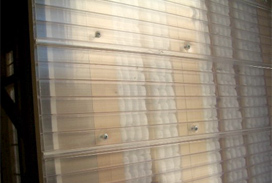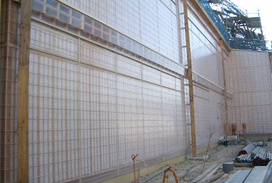Biodegradable Plastic Exterior Wall
- Japan Pavilion Nagakute -
EXPO 2005 Aichi, Japan has used and introduced biodegradable plastics in every corner of the Exhibition site. Biodegradable plastics are often used for eating utensils and banners; the Japan Pavilion Nagakute north exterior wall is also made of biodegradable plastic.
Biodegradable plastics are made from the starch of corn or other agricultural products, as well as food waste. As indicated in the following photographs, the exterior wall of the Pavilion is built using 220 transparent biodegradable plastic panels (1.5 m ´ 2.0 m each), which are attached to wooden frames. Foamed shock-absorbing materials are placed between the wooden frames to impart heat-insulating property. Also, this structure allows natural light to enter the Pavilion through the clearance between the foamed materials, saving lighting energy inside the Pavilion during daytime hours.

Panels made of Biodegradable plastic

Biodegradable plastic exterior wall
This is the first use of such biodegradable plastics for exterior wall; to confirm feasibility, various performance examinations were carried out, including outdoor exposure tests, water spray tests, heat-resistance tests and impact resistance tests. EXPO 2005 Aichi will also serve as a testing ground for this use. (Unfortunately due to the wall’s location, Pavilion visitors cannot observe the actual exterior, but it will be presented on video and by other means at the Pavilion.)
For details, please visit the Japan Pavilion Nagakute website (biodegradable plastic exterior wall).


